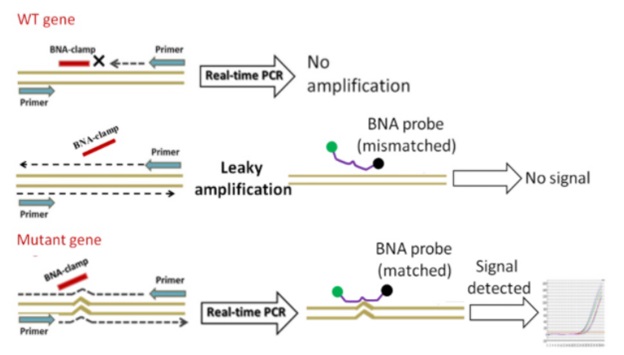BNA PCR clamping is a method to identify rare mutations in DNA species. BNA PCR clamping is an efficient and rapid method for the selective amplification of DNA target sequences or templates that differ by a single base pair.

BNA PCR clamping utilizes the high affinity and specificity of bridged nucleic acid (BNA) probes to their complementary target nucleic acid sequence, allowing them to resolve single-base differences in template strands available for amplification detection.
BNA PCR clamping is a method to identify rare mutations in DNA species. BNA PCR clamping is an efficient and rapid method for the selective amplification of DNA target sequences or templates that differ by a single base pair.

Figure 1: Schematic illustration of the BNA PCR clamping method. A set of generic primers and a BNA probe is used for selective amplification of mutant alleles.
PCR Protocol for BNA clamping: BNA PCR clamping enables detection of single point mutations.
Many mutations in human signaling and membrane receptor proteins are the cause of many cancers. Screening for these mutations allows identification of biomarkers that indicate the risk of a patient’s for developing cancer. In addition, after a particular cancer type in a patient has been diagnosed, it is important to screen for resistant of the identified cancer type to therapeutic drugs. Read on ....
What is PCR clamping?
The technique known as PCR Clamping imparts the ability to resolve single-base differences in template strands available to amplify or detect. Read on …
BNA Clamp PCR Oligonucleotides
BNA Clamp PCR delivers unmatched specificity and superior sensitivity. Read on …
Clamp oligonucleotides inhibit DNA primer extension on a single-stranded template. They can also arrest reverse transcription on a single-stranded RNA template. Clamp oligonucleotides are useful tools for sequence-specific control of gene expression as therapeutic agents as well as BNA clamp probe-based real-time PCR foor the detection of mutated genes. Read on ...
Point Mutation Detection
Molecular probes containing BNAs at selected positions in combination with real-time PCR allow the detection of pathogen mutants that can cause various disorders in humans. Read on ...
Effective Detection Method for the EGFR Single Mutation T790M
Mutations on epidermal growth factor receptor (EGFR) cause a variety of cancers including breast and lung cancers. The single mutation T790M on tyrosine kinase domain of EGFR signifies the response to the popular cancer drug gefitinib, which leads to the development of resistance to gefitinib. Read on ..
---...---